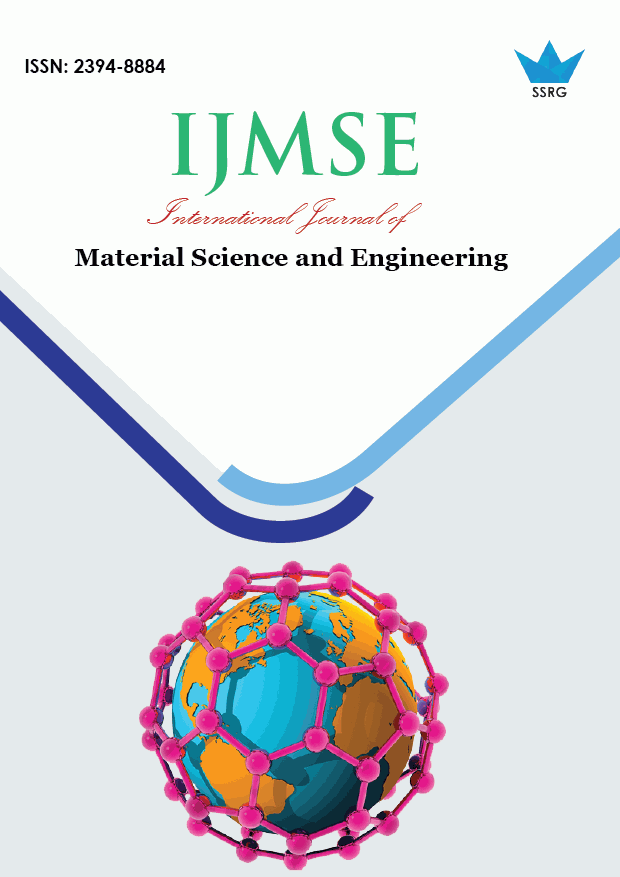Simulation of Solar Cell using SCAPS 1-D and Effect of Defect Density on Lead-Free Solar Cell Performance

| International Journal of Material Science and Engineering |
| © 2025 by SSRG - IJMSE Journal |
| Volume 11 Issue 2 |
| Year of Publication : 2025 |
| Authors : Anjali Vishnoi, Jitendra Kumar Kushwaha, Rahul Kaushik |
How to Cite?
Anjali Vishnoi, Jitendra Kumar Kushwaha, Rahul Kaushik, "Simulation of Solar Cell using SCAPS 1-D and Effect of Defect Density on Lead-Free Solar Cell Performance," SSRG International Journal of Material Science and Engineering, vol. 11, no. 2, pp. 1-4, 2025. Crossref, https://doi.org/10.14445/23948884/IJMSE-V11I2P101
Abstract:
Perovskite Solar Cells (PSCs), recognized as third-generation photovoltaic devices, offer significant commercialization potential due to their impressive Power Conversion Efficiencies (PCE). Challenges such as limited stability and performance degradation over time persist. Numerical modelling, performed using SCAPS1-D, identified the defect tolerance levels in the absorber and other layers present in a solar cell. Increasing the defect density directed to a substantial decline in PCE from 29.04% to 25.94%. Simulations estimated the impacts of metal type, material, and its acceptor or donor densities in the electron transport layer, providing deeper insights into the correlation between defect mechanisms and PSC performance along with free charges of the active layer. During simulation, the total defect density of the CH3NH3SnI3/FTO interface increases, and efficiency falls to 25.94% from 29.04%. and fill factor reduced to 75.5% from 84.42%. The thickness of the absorber layer used is 0.450 um. The less defect density, the more efficient the solar cell will be.
Keywords:
Simulation, Defect density, Charge carrier, Efficiency, Fill factor, PCE.
References:
[1] M. Burgelman, P. Nollet, and Stefaan Degrave, “Modelling Polycrystalline Semiconductor Solar Cells,” Thin Solid Films, vol. 361 362, 527-532, 2000.
[CrossRef] [Google Scholar] [Publisher Link]
[2] Marc Burgelman et al., “Modelling Thin-Film PV Devices,” Progress of Photovoltaics, vol. 12, no. 2-3, pp. 143-153, 2004.
[CrossRef] [Google Scholar] [Publisher Link]
[3] R.R. Hernandez et al., “Environmental Impact of Utility-scale Solar Energy,” Renewable and Sustainable Energy Reviews, vol. 29, pp. 766-779, 2014.
[CrossRef] [Google Scholar] [Publisher Link]
[4] H. Gunerhan, A. Hepbasil, and U. Giresunlu, “Environmental Impacts from the Solar Energy System,” Energy Sources, Part A: Recovery, Utilization, and Environmental Effects, vol. 31, no. 2, pp. 131-138, 2008.
[CrossRef] [Google Scholar] [Publisher Link]
[5] Shruti Sharma, Kamlesh Kumar Jain, and Ashutosh Sharma, “Solar Cells, in Research and Applications-A Review,” Material Science and Application, vol. 6, no. 12, pp. 1145-1155, 2015.
[CrossRef] [Google Scholar] [Publisher Link]
[6] Hamed H. Pourasl, Reza Vatankhah Banerji, and Vahid M. Khojastehnezhad, “Solar Energy Status in the World; A Comprehensive Review,” Energy Reports, vol. 10, pp. 3474-3493, 2023.
[CrossRef] [Google Scholar] [Publisher Link]
[7] Ali OM. Maka, and Jamal M. Alabid, “Solar Energy Technology and its Roles in Sustainable Development,” Clean Energy, vol. 6, no. 3, pp. 476-483, 2022.
[CrossRef] [Google Scholar] [Publisher Link]
[8] Nima Khoshsirat, and Nurul Amziah Md Yunus, “Numerical Simulation of CIGS Thin Film Solar Cells Using SCAPS-1D,” 2013 IEEE Conference on Sustainable Utilization and Development in Engineering and Technology (CSUDET), Selangor, Malaysia, pp. 63-67, 2013.
[CrossRef] [Google Scholar] [Publisher Link]
[9] Hyun-Jae Park, Hyojung Son, and Byoung-Seong Jeong, “SCAPS-1D Simulation for Devices Optimization to Improve Efficiency in Lead-Free CsSnI3 Perovskite Solar Cells,” Inorganics, vol. 12, no. 4, pp. 1-16, 2024.
[CrossRef] [Google Scholar] [Publisher Link]
[10] Ateeq ul Rehman et al., “Enhanced Solar Cell Efficiency with Tin-Based Material (FASnI3) through SCAPS-1D Modelling,” Eurasian Journal of Science and Technology, vol. 4, no. 3, pp. 244-252, 2024.
[CrossRef] [Google Scholar] [Publisher Link]
[11] R. Jeyakumar et al., “Influence of Electron Transport Layer (TiO2) Thickness and Its Doping Density on the Performance of CH3NH3PbI3-Based Planar Perovskite Solar Cells,” Journal of Electronic Materials, vol. 49, pp. 3533-3539, 2020.
[CrossRef] [Google Scholar] [Publisher Link]
[12] Anthony C. Ozurumba et al., “SCAPS-1D Simulated Organometallic Halide Perovskite: A Comparison of Performance under Sub Saharan Temperature Condition,” Heliyon, vol. 10, no. 8, pp. 1-15, 2024.
[CrossRef] [Google Scholar] [Publisher Link]
[13] Rahutosh Ranjan et al., “SCAPS Study on the Effect of Various Hole Transport Layer on Highly Efficient 31.86% Eco-friendly CZTS based Solar Cell,” Scientific Reports, vol. 13, pp. 1-16, 2023.
[CrossRef] [Google Scholar] [Publisher Link]
[14] Saumya Vaish, and Shiv Kumar Dixit, “Study the Effect of Total Defect Density Variation in Absorbing Layer on the Power Conversion Efficiency of Lead Halide Perovskite Solar Cell using SCAPS1-D Simulation,” Materials Today, vol. 91, pp. 17-20, 2023.
[CrossRef] [Google Scholar] [Publisher Link]
[15] M.S. Chowdhury et al., “Effect of Deep-level Defect Density of the Absorber Layer and n/i Interface in Perovskite Solar Cells by SCAPS-1D,” Results in Physics, vol. 16, pp. 1-6, 2020.
[CrossRef] [Google Scholar] [Publisher Link]
[16] Ruiqi Zhu et al., “Enhancing Crystalline Silicon Heterojunction Solar Cells by Long Persistent SrAl2O4:(Eu2+, Dy3+) Phosphors,” Solar Energy Materials and Solar Cells, vol. 285, 2025.
[CrossRef] [Google Scholar] [Publisher Link]
[17] Z. Younsi et al., “Scrutinizing Transport Phenomena and Recombination Mechanisms in thin film Sb2S3 Solar Cells,” Scientific Reports, vol. 14, pp. 1-19, 2024.
[CrossRef] [Google Scholar] [Publisher Link]
[18] M. Mostefaoui et al., “Simulation of High Efficiency CIGS Solar Cell with SCAPS-1D Software,” Energy Procedia, vol. 74, pp. 736-744, 2015.
[CrossRef] [Google Scholar] [Publisher Link]
[19] Md. Samiul Islam et al., “Defect Study Modelling of SnX3- based Perovskite Solar Cells with SCAPS-1D,” Nanomaterials, vol. 11, no. 5, pp. 1-14, 2021.
[CrossRef] [Google Scholar] [Publisher Link]
[20] Syeda Maria Sultana et al., “Defect Density Dependent Performance Analysis of Perovskite Solar Cell for Different Transport Layer,” Journal of Optoelectronics and Communication, vol. 5, no. 1, pp. 1-10, 2023.
[Google Scholar] [Publisher Link]

 10.14445/23948884/IJMSE-V11I2P101
10.14445/23948884/IJMSE-V11I2P101